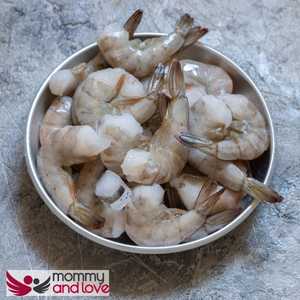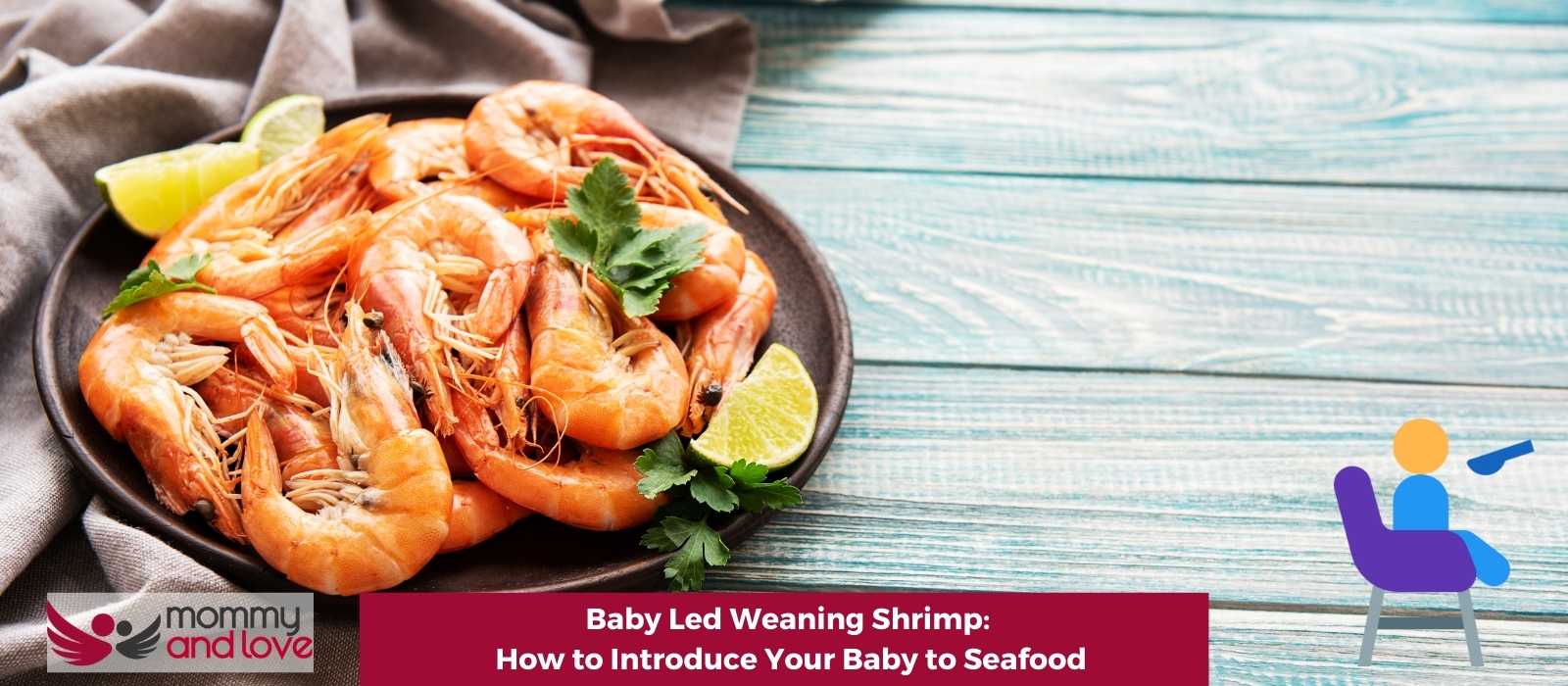If you’re looking for a nutritious way to introduce your baby to seafood, look no further than shrimp!
Shrimp is the perfect finger food for babies who are starting to develop their taste buds and explore new flavors. In this blog post, we will show you how to make this easy and healthy recipe at home!
Is Shrimp Healthy for Babies?
You may be wondering if shrimp is a healthy option for your baby’s diet. The answer is yes! Shrimp is a great source of protein and omega-three fatty acids, both of which are essential for a baby’s growth and development.
Omega-3 Fatty Acids
Omega-3 fatty acids play an important role in normal brain development and help support the immune system. Most importantly, omega-3 fatty acids support cognitive health and development, cardiovascular health, and emotional well-being. We encourage eating salmon if you are breastfeeding and like shrimp, its great for kids as well.
Protein
Protein is one of the most important nutrients for your baby’s growth and development. For example, it supports the building of healthy muscle, bone, skin and blood. It also helps your baby’s body produces antibodies that fight off viruses and bacteria.
Vitamin B12
Babies need B12 for proper brain development and to make red blood cells that carry oxygen in the body. If they are deficient in B12, they can have developmental delays, anemia, which can then lead to fatigue and paleness.
Choline
Shrimp also contains choline which is an essential nutrient that helps your brain and nervous system function properly. It is naturally found in breast milk, which makes breastfeeding a good way to ensure that your child is getting enough of this nutrient during their first 6 months.
Zinc
Zinc can help the development of a child because it helps the growth and development of cells. The body needs zinc to make proteins and DNA, the genetic material in all cells. It also helps with wound healing and your sense of taste and smell. During pregnancy, infancy, and childhood, the body needs zinc to grow and develop properly.
When Can Babies Eat Shrimp?
Although it is possible to introduce shrimp as soon as your child starts solids, many parents find that their first birthday provides a more appropriate milestone. The soft texture of this popular seafood can be difficult for babies who might have trouble breaking down food items that have a slippery and chewy texture. Additionally, shrimp is naturally high in sodium which is not ideal for growing babies.
Is Shrimp a Common Allergen?
Shrimp is a common food allergen. If you or your partner have a shrimp allergy, it’s important to avoid giving this seafood to your child. Additionally, if there is a history of allergies in your family, you may want to speak with your pediatrician before you add shrimp to your baby’s diet.
Shrimp Allergies in Babies
Shrimp is a common food allergen and babies that have a shellfish allergy are also allergic to other shellfish such as crab and lobster. Shrimp allergy symptoms are typically the same as those seen with other allergenic foods. If your baby has a shrimp allergy, you will need to avoid giving them shrimp or any foods that contain shrimp. Talk to your baby’s doctor before you add shrimp back to her diet.
Shrimp Allergy Symptoms

A baby with a shrimp allergy may experience hives or swelling on their face or neck after eating shrimp.
They may also have breathing problems after eating shellfish and may experience difficulty breathing, wheezing or tightness in their throat or chest. Note that this allergy is different than finned fish allergy.
A serious allergic reaction can cause anaphylaxis — which requires immediate medical attention — and can include difficulty breathing, nausea, vomiting, diarrhea, dizziness and loss of consciousness.
Is Shrimp a Choking Hazard for Babies?
As with any food you introduce to your child, there is a risk of choking. Shrimps are small, round and slippery, which makes them a potential choking hazard. If you’re giving your child whole shrimps, remove the tails first and cut the shrimp into quarters or smaller pieces before serving. Keeping the tail on can be dangerous because a strand of shrimp tail can become lodged in the throat of a struggling child. Although chunks of shrimp meat aren’t likely to cause a choking hazard, it’s important to supervise your infant during meals and watch for signs of choking.
Signs of Choking
A baby who is starting to choke will struggle more than usual with his mouth open as he tries to breathe around the food lodged in his throat. His face may turn red or white and he may cough or gag loudly. Other signs include pulling at his ears or holding his neck stiffly in place with an arched back.
How Much Shrimp Can Babies Have?
According to the Environmental Defense Fund’s Seafood Selector chart, 1 ounce of shrimp contains 0.09 parts per million (ppm) of mercury. The higher a food’s mercury content is, the less you should feed your child. Because shrimp has such a low mercury content, children under age 2 can safely eat it once a week.
Can Babies Eat Raw Shrimp?

Raw shrimp is not safe for babies or toddlers because of the risk of food poisoning and bacteria called Vibrio. Eating raw shrimp can lead to an upset stomach, vomiting, diarrhea, and even fever.
If you’re concerned your child has eaten uncooked or undercooked shrimp or is showing symptoms of food poisoning, call your pediatrician right away.
An upset stomach is a common symptom of food poisoning, as well as vomiting and diarrhea. Symptoms like fever are more severe signs that should be monitored closely by your pediatrician.
Vibrio causes illness in people who eat raw or undercooked seafood (such as oysters), or who have an open wound that comes into contact with seawater. Any person can get Vibrio infection if they eat contaminated seafood. Anyone with a weakened immune system is at greater risk for developing a severe infection.
Symptoms of Vibrio infection include:
- fever
- chills
- abdominal pain
- diarrhea with bloody stools
How Do You Prepare Shrimp for Babies With Baby-Led Weaning
You can easily introduce raw shrimp to babies who are ready for solids, but you need to follow a few food safety rules:
- Make sure your child is developmentally ready. A baby may be ready to start eating solid food between 4 and 6 months of age. Before then, their digestive system isn’t developed enough, and they won’t get the nutrients they need from solid foods.
- Buy frozen, raw shrimp that has been treated to eliminate parasites. Parasitic infections can be fatal in babies. Always cook shrimp that hasn’t been treated or frozen.
- Prepare shellfish safely. Thaw frozen shrimp in the refrigerator overnight before cooking it. Slice and cook the shrimp until both its flesh and juices are opaque and it reaches an internal temperature of 145 degrees Fahrenheit. Cooked shrimp doesn’t need to be heated for a second time before serving it to your baby as long as you don’t add any other ingredients that may contain bacteria, such as raw vegetables or condiments.
- You can add small amounts of spices such as paprika, garlic, onion and pepper.
- As always, be sure to use peeled-and-deveined shrimp (with no additives or seasonings) that has been fully cooked before pureeing.
- A food processor is absolutely not necessary at all, but it does make the job quick and easy. If you have one that you’d like to use, especially if you have other children to feed as well, we recommend putting the peeled-and-deveined shrimp into your food processor when it’s time to start cooking. Process it on “pulse” until it’s finely chopped (but stop before it turns into mush!). You can also use a sharp knife or mini-chopper.
- Keep chopped shrimp in the refrigerator for no longer than two days or freeze it for up to three months for future meals. Make sure your child eats the entire portion at one sitting to avoid possible bacterial growth on leftovers, even if it means throwing away some frozen shrimp.
- When you’re ready to serve the cooked shrimp, remove the tails and cut the shrimp into small pieces. You can either give your child whole cooked shrimp or mix it with other foods, such as rice, pasta, or vegetables. If you’re mixing it with other foods such as veggies and eggs, be sure to chop the shrimp into even smaller pieces.
Flavor Pairings and Other Infant-Friendly Shrimp Recipes
- Chop the shrimp into small pieces or use a food processor.
- Make sure they are nice and cool before serving them to your kids.
- Steam or boil the shrimp.
- Use a sauce that is also infant-friendly. Or serve with a store-bought dip, like yogurt or hummus.
- Shrimp cakes are a delicious alternative to fish fingers. They’re full of seafood and vegetables, so you can give them to your child from six months onwards. Use parchment paper and a baking sheet. The shrimp cakes are soft enough for babies to eat safely and the mixture freezes well if you want to make extra portions.
- Stir fry the cut-up shrimp with other vegetables and olive oil.
- Bake shrimp as part of a casserole or with cheese on top for a creamy texture.
Takeaway
It’s never too early to introduce your little one to the world of seafood. In fact, whole shrimp is a healthy way to introduce seafood to your baby’s diet, and there are easy ways to do it through self-feeding and when they are ready for solid foods.
Shrimp is packed with protein, selenium and vitamin D — nutrients that are important for a growing baby. It also has omega-3 fatty acids that are beneficial for brain and eye development. But before you get started, keep the following in mind:
- Shrimp should be thoroughly cooked before serving it to your child. The best way is to steam or poach it until it turns pink and opaque all the way through. If you want to bake it, you can use parchment paper or a baking sheet. Wait until they are golden brown and cooked before taking them out of the oven.
- Prawns are often sold frozen in supermarkets and available already cooked at sushi counters in some grocery stores; even if properly thawed, they should still be cooked before serving to your child.
- You can also cook whole shrimp with other foods, such as pasta dishes or stir-fries. Just remember that some of these foods may trigger allergies, so it’s best to check with your pediatrician for professional medical advice before adding anything new to your baby’s diet.

This article was written by Sandra Baker – full time writer and the mother of four amazing kids (including twins!)
She’s also a breastfeeding counselor and has spent years helping new parents learn how to care for their children. When she’s not writing or caring for her children, Sandra likes to spend time reading and taking walks with her husband.




